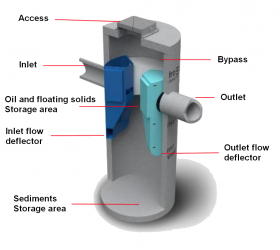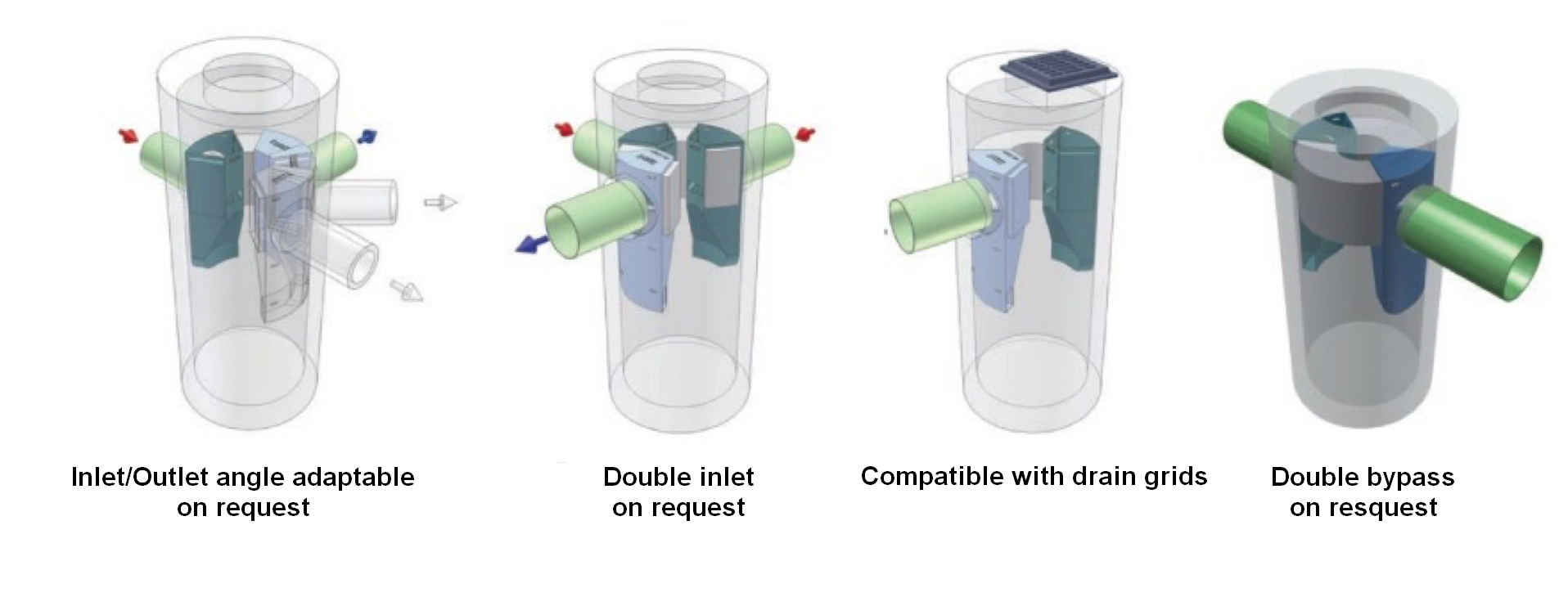The First Defense® is an economical solution for hydrodynamic vortex separation of sediments, floating solids and light liquids present in runoff waters. By ensuring the non-release of the pollutants, which are collected and stored, the system protects the receiving environment from harmful pollutants.
Application
Rainwater treatment before storage, retention, discharge and infiltration.
Operation
The internal components of the First Defense® have been carefully designed to create a low-intensity rotational flow in the system in order to optimise the separation of pollutants. This vortex separation allows the sediments to be stored in the lower part of the containment zone while oils, floating solids and other light elements are stored in the upper part.
The bypass makes it possible to immediately direct exceptionally heavy rains toward the output. This design avoids turbulent flows and therefore prevents the release of captured pollutants. In addition, the low energy vortex separator generates a tranquilised flow, thus preventing the re-suspension of pollutants captured during heavy rainfall.
Efficiency
The advanced hydrodynamic vortex separation solution, First Defense®, whose performance has been validated by laboratory tests on several effluent granulometry [1] and by independent third-party organisations is illustrated below.
| First Defense® 1.0 | 80% abatement at 21 l/s |
| First Defense® 1.2 | 80% abatement at 29 l/s |
| First Defense® 1.8 | 80% abatement at 107 l/s |
Table 1: Processing capacity by hydraulic flow and system size
[1] Particle Size Distribution D50 110 μ
Implementation
Installing a First Defense® system is as easy as installing a conventional plastic manhole. The system is delivered ready for installation. Please refer to the First Defense® system technical data sheet.
Maintenance
The maintenance of a First Defense® is simple and fast. The required operations are comparable to the maintenance of a dump chamber. A conventional cleaning truck, with no special equipment, is used to drain the system and return it to service after cleaning. No items need to be disassembled.
Adaptability
The First Defense® system can be custom-made according to the connection diameters of the network as well as their layout. The angles will be tailor-made according to the specificities of the project.
Illustration

Figure 1 : First Defense®, Ø 1’800 mm treatment flow 90 l/s

Figure 2 : First Defense® upstream of a Rigofill® system
First Defense® protects the natural environment and storage structures by removing a wide range of pollutants from runoff.
General information
First Defense® allows easy and safe inspection. A conventional cleaning truck is used to remove captured sediment and floating matter.
The point of access to the structure is in the upper part via the cover. The maintenance of removal of hydrocarbons, light liquids, floating solids and sludge is done from the outside. No human intervention within the system is necessary.
Maintenance operations do not require disassembly.
Maintenance schedule
The frequency of maintenance is determined on-site after installation. The frequency of maintenance is determined on the site after installation. During the first year of operation, the unit must be inspected every six months to determine the rate of sediment and floating matter accumulation.
This information can be recorded in the maintenance log (see end of document) to establish a routine maintenance schedule.
A visual inspection should be carried out once a year.
A system and network maintenance operation must be performed in the event of a spill.
The cleaning/suction procedure, of both sediment and floating solids and light liquids, typically takes less than 30 minutes.
Procedure
- Set up the necessary security equipment around the First Defense® access as stipulated by the regulations in force,
- Remove the grill or cover from manhole,
- Without going into the manhole, look inside. Take note of any irregularities,
- Vacuum the floating solids and any light liquids at the top of the system (Figure 1),
- Then proceed with the suction of the sludge at the bottom of the manhole (Figure 2),
- Remove the suction hose,
- Return the system and the cover to clear water,
- Fill out the maintenance log.









